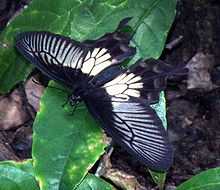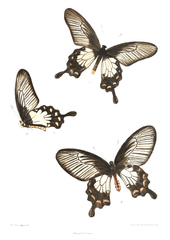Pachliopta pandiyana
| Malabar Rose | |
|---|---|
 | |
| Scientific classification | |
| Kingdom: | Animalia |
| Phylum: | Arthropoda |
| Class: | Insecta |
| Order: | Lepidoptera |
| Family: | Papilionidae |
| Genus: | Pachliopta |
| Species: | P. pandiyana |
| Binomial name | |
| Pachliopta pandiyana[1] (Moore, 1881) | |
| Synonyms | |
|
Atrophaneura pandiyana | |
Malabar Rose (Pachliopta pandiyana) is a swallowtail butterfly belonging to the Pachliopta genus, the Roses, or the Red-bodied Swallowtails. It resembles the Common Rose (Pachliopta aristolochiae) from which it can be differentiated by the much larger white patch on its hindwings.
It is an important endemic butterfly of South India.
Description
- See glossary for terms used
This was earlier considered a race of Atrophaneura jophon found in Sri Lanka.

Description of A. jophon - Male upperside black. Fore wing with three or four broad white streaks in cell and a variable number of similar somewhat broader streaks that are bifid along their apical half in the interspaces beyond; these streaks do not reach the terminal margin and become obsolete towards the costal margin of the wing. Hind wing: the apical half of the cell and short apically truncate streaks in the interspaces beyond white; these streaks broad, divided only by the black veins, followed by a subterminal curved series of crimson lunules irrorated with black scales. Underside similar, the markings more distinct and more sharply defined, the discal white streaks and the subterminal series of crimson spots each seven in number. Antennae, head, thorax and abdomen above up to the preanal segment black; the head in front and beneath, the thorax at the sides and the apical half of the abdomen crimson, the last with one or two black lateral spots.— Female similar; fore wing broader, the while and crimson markings larger and more conspicuous.[2]
Race pandiyanus, Moore.—"Though closely allied to A. jophon Gray, this species is constantly different in pattern. The white colour of the fore wings is much more extended, especially in the apical region, but also more shaded with black scales; the internervular black streaks between the median nervures (veins 4-6) are much longer, the white linear markings, in the cell reach the discocellular veinlets. On the hind wing the last discal white spot reaches mostly to the submedian nervure (vein 1), the anterior one is very large in the male, small or divided into two spots, or obliterated in the female...". (Rothschild, quoted in Bingham)
Similar Species

Range
Southern India. The butterfly does not associate much with the Common Rose, which it resembles. On the western slopes of the Nilgiris and elsewhere on the Western Ghats, the Malabar Rose entirely displaces that most abundant butterfly.
Status
Uncommon, but not considered to be threatened as a species. Locally common in the Western Ghats.
Taxonomy
- A related species, Atrophaneura jophon, once considered conspecific, flies in Sri Lanka.
- No separate subspecies have been described.
Habitat
This butterfly is confined to the wet jungles of Southern India and the Western Ghats, between 1000 to 3,000 feet (910 m).
Habits
The flight of this butterfly resembles that of the Common Rose Atrophaneura aristolochiae. Early in the morning till about 10 O'clock, it keeps low and feeds from flowers, usually those of the Lantana. Later in the day it flies high and is difficult to capture.
Lifecycle
Appears to be single-brooded. Commonest in September and October.
Foodplants
The larval foodplant is Thottea siliquosa (Aristolochiaceae).
See also
Cited references
- ↑ Häuser, Christoph L.; de Jong, Rienk; Lamas, Gerardo; Robbins, Robert K.; Smith, Campbell; Vane-Wright, Richard I. (28 July 2005). "Papilionidae – revised GloBIS/GART species checklist (2nd draft)". Entomological Data Information System. Staatliches Museum für Naturkunde Stuttgart, Germany. Retrieved 21 June 2013.
- ↑ Bingham, C. T. 1907. The Fauna of British India, Including Ceylon and Burma. Butterflies. Volume 2
References
- Collins, N.M. & Morris, M.G. (1985) Threatened Swallowtail Butterflies of the World. IUCN. ISBN 2-88032-603-6
- Evans, W.H. (1932) The Identification of Indian Butterflies. (2nd Ed), Bombay Natural History Society, Mumbai, India
- Gaonkar, Harish (1996) Butterflies of the Western Ghats, India (including Sri Lanka) - A Biodiversity Assessment of a threatened mountain system. Journal of the Bombay Natural History Society.
- Gay,Thomas; Kehimkar,Isaac & Punetha,J.C.(1992) Common Butterflies of India. WWF-India and Oxford University Press, Mumbai, India.
- Kunte,Krushnamegh (2005) Butterflies of Peninsular India. Universities Press.
- Wynter-Blyth, M.A. (1957) Butterflies of the Indian Region, Bombay Natural History Society, Mumbai, India.
External links
- http://www.angelfire.com/journal2/chinfahshin/history/rose.html
- http://www.srilankaninsects.net/Butterflies/Papilionidae/CommonRose/CommonRose.htm
| ||||||||||